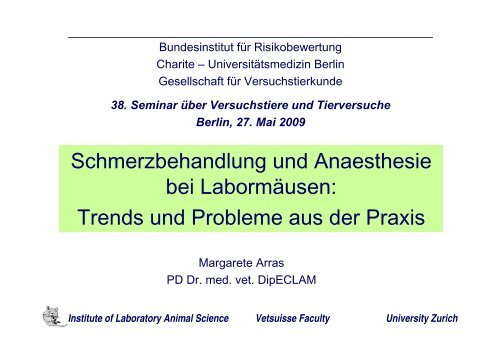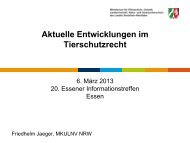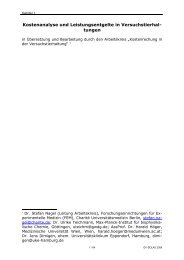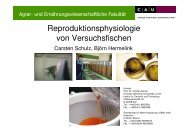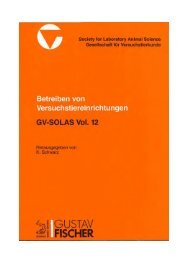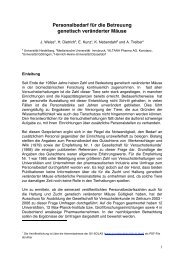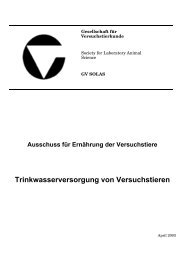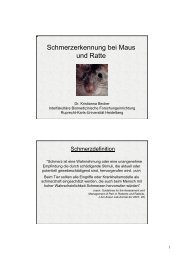Trends und Probleme aus der Praxis - GV-Solas
Trends und Probleme aus der Praxis - GV-Solas
Trends und Probleme aus der Praxis - GV-Solas
You also want an ePaper? Increase the reach of your titles
YUMPU automatically turns print PDFs into web optimized ePapers that Google loves.
B<strong>und</strong>esinstitut für Risikobewertung<br />
Charite – Universitätsmedizin Berlin<br />
Gesellschaft für Versuchstierk<strong>und</strong>e<br />
38. Seminar über Versuchstiere <strong>und</strong> Tierversuche<br />
Berlin, 27. Mai 2009<br />
Schmerzbehandlung <strong>und</strong> Anaesthesie<br />
bei Labormäusen:<br />
<strong>Trends</strong> <strong>und</strong> <strong>Probleme</strong> <strong>aus</strong> <strong>der</strong> <strong>Praxis</strong><br />
Margarete Arras<br />
PD Dr. med. vet. DipECLAM<br />
Institute of Laboratory Animal Science Vetsuisse Faculty<br />
University Zurich
Goals<br />
Anesthesia<br />
– species-specific problems in mouse anesthesia<br />
– types of anesthesia<br />
• injection anesthesia<br />
• inhalation anesthesia<br />
‣examples, problems<br />
‣optimized protocols<br />
Pain therapy<br />
– decide on pain therapy<br />
– drugs, side effects<br />
– dosages<br />
‣intensive post-operative care in mice
Species-specific problems in mouse anesthesia<br />
the mouse<br />
– 18 – 50 g body weight<br />
– hypothermia<br />
– access to arteries, veins<br />
– injection side<br />
the drugs<br />
– feasibility<br />
Propofol ® , diazepam, di-ethyl-ether, …<br />
– availability<br />
InnovarVet ® > off the market<br />
Hypnorm ® > narcotics laws, import from UK<br />
–<br />
i.p., s.c.<br />
Halothane > off the market?<br />
monitoring<br />
Metofane ® > import from Australia<br />
blood pressure<br />
heart rate, ECG<br />
– regulations for protection of the personnel<br />
secure gas scavenging<br />
pulsoximetry<br />
blood gases and acid base balance<br />
– legal restrictions from welfare concerns<br />
Avertin ® , di-ethyl-ether, …<br />
– intervention<br />
cardiac arrest<br />
respiratory depression
Species-specific problems in mouse anesthesia
Avertin ®<br />
Tribromoethanol<br />
Zeller, W., Meier, G., Bürki, K., Panoussis, B.: Adverse<br />
effects of tribromoethanol as used in the production of<br />
transgenic mice. Laboratory animals, 1998, 32, 407-13<br />
Lieggi, C.C., Fortman, J.D., Kleps, R.A., Sethi, V., An<strong>der</strong>son,<br />
J.A., Brown, C.E. Artwohl, J.E.: An evaluation of<br />
preparation methods and storage conditions of<br />
tribromoethanol. Contemporary topics in laboratory animal<br />
science, 2005, 44/1, 11-16<br />
Lieggi, C.C., Artwohl, J.E.Leszczynski, J.K., Rodriguez, N.A.,<br />
Fickbohm, B.L., Fortman, J.D.: Efficacy and safety of<br />
stored and newly prepared tribromoethanol in ICR mice.<br />
Contemporary topics in laboratory animal science, 2005,<br />
44/1, 17-22<br />
Chu, D.K., Jordan, M.C., Kim, J.K., Couto, M.A., Roos, K.P.<br />
Comparing isoflurane with tribromoethanol anesthesia<br />
for echocardiographic phenotyping of transgenic mice.<br />
Journal of the American Association for Laboratory Animal<br />
Science, 2006 45(4): 8-13<br />
Web page of the german society for laboratory animal<br />
science:Stellungnahme des Auschuss für Anesthesie<br />
<strong>und</strong> Analgesie des <strong>GV</strong>-SOLAS zur Anaesthesie von<br />
Labormäusen mit Tribromethanol, www.gv-solas.de
Types of anesthesia: route of application<br />
Injection<br />
ease of application<br />
– i.p.<br />
– s.c.<br />
special equipment: none<br />
environmental impact: no<br />
cheap ?<br />
not controllable<br />
Inhalation<br />
application<br />
– induction chamber<br />
– face mask<br />
special equipment<br />
environmental impact ?<br />
dangerous for personnel ?<br />
expensive ?<br />
controllable<br />
Mono-anesthetics<br />
e.g. pentobarbital<br />
Isoflurane<br />
Sevoflurane<br />
Desflurane<br />
Combination of<br />
dissoziative + alpha-two agonist<br />
e.g. ketamin + xylazine<br />
Combination of<br />
opioid + alpha-two agonist<br />
e.g. fentanyl + medetomidine<br />
Halothane<br />
Enflurane<br />
Methoxyflurane<br />
Di-ethyl-ether
Injection anesthesia<br />
Combination of substances<br />
synergistic action<br />
– adverse effects decreased<br />
– desired effects increased<br />
– analgesia strengthened<br />
α 2 -agonist<br />
opioid<br />
tranquilizer<br />
dissoziative<br />
examples<br />
– neurolept-analgesia<br />
‣fentanyl + fluanison (Hypnorm ® ) + medetomidine<br />
‣fentanyl and medetomidine can be antagonized<br />
‣fentanyl + midazolam + medetomidine<br />
‣all components can be antagonized<br />
[from J. Henke, Munich]<br />
– ketamin + xylazine (Rompun ® ) [+ acepromazine]
Handling b Lack of toxicity c Efficacy d References<br />
Table 1. Details of published i.p. injection anesthesia protocols for the mouse.<br />
Substances Range of Substance class Availability<br />
dosages<br />
[mg/kg]<br />
a<br />
Mono-anesthetics<br />
Pentobarbitone<br />
30 – 90 Barbiturate – n + – narrow safety margin – analgesia insufficient, long<br />
sleeping time<br />
3, 5, 7, 13, 14,<br />
15, 16<br />
α-Chloralose 114 – – difficult to dissolve in saline – matter of controversy – no surgical tolerance 5<br />
Chloral hydrate<br />
60 - 400 – n – not available in sterile form, – high mortality, intestinal com-<br />
– controversial: analgesia 5, 16<br />
light sensitive, air sensitive plications, out of use today insufficient<br />
Etomidate 23.7 - 33 Non-barbiturate – c + – tissue irritant – only hypnosis, no analgesic<br />
5, 23, 24<br />
hypnotic<br />
properties<br />
Combinations of anesthetics<br />
Ketamine 50 – 200 Dissociative + + * analgesia, no relaxation 5, 12, 13, 14, 15,<br />
+ Xylazine 5 – 20 α2-Agonist * analgesia, sedation 16<br />
Ketamine 75 Dissociative + + * analgesia, no relaxation 14, 15, 18, 19,<br />
+ Medetomidine<br />
1 α2-Agonist + + * analgesia ?, sedation ? 20, 21<br />
relaxation ?<br />
Ketamine<br />
+ Azaperone<br />
100<br />
75<br />
Dissociative<br />
Butyrophenone<br />
+ + * analgesia, no relaxation 16, 17<br />
Tiletamin/<br />
Zolazepam<br />
(Telazol)<br />
7.5 – 100 Dissociative/<br />
Benzodiazepine<br />
+ + * Telazol alone: only immobilization<br />
+Xylazine 7.5 – 45 α2-Agonist + + * analgesia, sedation<br />
Fentanyl/<br />
Fluanison<br />
(Hypnorm)<br />
0.33 – 3.3<br />
[ml/kg]<br />
Opioid/<br />
Butyrophenone<br />
– n, c – precipitates out of solution,<br />
difficult to mix with other<br />
drugs, storage of mixtures not<br />
* neuroleptanalgesia<br />
possible<br />
+ Midazolam 12.5 – 16.6 Benzodiazepine – c * sedation 26<br />
or<br />
+ Diazepam 5 Benzodiazepine + + * sedation 5, 14<br />
Fentanyl/<br />
droperidol<br />
(Innovar-<br />
Vet)<br />
0.0001 –<br />
0.001<br />
[ml/g]<br />
Opioid /<br />
Butyrophenone<br />
– n,<br />
c, o<br />
+ * neuroleptanalgesia 5, 16<br />
5, 7<br />
5, 14, 15, 16, 22,<br />
+ Diazepam 5 Benzodiazepine + + * sedation<br />
Fentanyl 0.06 - 0.08 Opioid – n, c + * analgesia 14, 15, 24<br />
+ Metomidate 60 Non-barbiturate – c + – tissue irritant;<br />
hypnosis<br />
hypnotic<br />
high mortality?<br />
Fentanyl 0.08 Opioid – n + * analgesia 15, 23, 24<br />
+ Etomidate 18 Non-barbiturate – c + – tissue irritant hypnosis<br />
hypnotic<br />
Carfentanyl 0.003 Opioid – n + – side effects: excitations, analgesia 5, 13, 23, 24<br />
muscle spasms<br />
+ Etomidate 15 Non-barbiturate<br />
hypnotic<br />
– c + – tissue irritant hypnosis<br />
a<br />
+ = commercially available; n = legal restrictions in some countries (narcotics act); c = not available in some countries; o = off the market.<br />
b<br />
+ = available in sterile form, easy to dilute or mix with other drugs, chemically stable, can be stored<br />
c<br />
Toxicity defined as mortality, tissue irritancy, other side effects. Safety margin = effective dose vs. toxic dose. * = no relevant experimental data in the mouse were fo<strong>und</strong>.<br />
d<br />
Efficacy defined in terms of the 3 components of anesthesia: analgesia, hypnosis, and muscle relaxation<br />
from Arras et al. Comp Med 2001
Sensitivity to injectable anesthetics influenced by...<br />
strain, sex, age<br />
•Rumke, C. L., and J. Noordhoek. 1969. Sex differences in the duration of<br />
hexobarbital narcosis and in serum MUP content in mice. Arch Int<br />
Pharmacodyn Ther 182(2):399-400.<br />
•Green, C. J. 1979. Chapter 1: General principles, p. 9-16. In C. J. Green<br />
(ed.), Animal Anaesthesia, Laboratory animal handbooks 8. Laboratory<br />
Animals Ltd., London.<br />
•Lovell, D. P. 1986. Variation in pentobarbitone sleeping time in mice. 1.<br />
Strain and sex differences. Lab Anim 20(2):85-90.<br />
•Lovell, D. P. 1986. Variation in pentobarbitone sleeping time in mice. 2.<br />
Variables affecting test results. Lab Anim 20(2):91-96.<br />
•Cruz, J. I., J. M. Loste, and O. H. Burzaco. 1998. Observations on the use<br />
of medetomidine/ketamine and its reversal with atipamezole for chemical<br />
restraint in the mouse. Lab Anim 32(1):18-22.<br />
•Homanics, G. E., J. J. Quinlan, and L. L. Firestone. 1999. Pharmacologic<br />
and behavioral responses of inbred C57BL/6J and strain 129/SvJ mouse<br />
lines. Pharmacol Biochem Behav 63(1):21-26.<br />
•Zambricki, E. A., D’Alecy, L. G. 2004. Rat sex differences in anesthesia.<br />
Comp Med 54 (1): 49-53<br />
• Avsaroglu, H, van <strong>der</strong> Sar, A.S., van Lith, H.A., van Zutphen, L.M.F.,<br />
Hellebrekers, L.J. 2007. Differences in the response to anaesthetics and<br />
analgesics between inbred rat strains. Lab Anim 41:337-344<br />
circadian rhythm, health,<br />
pregnancy, socio-physiological<br />
conditions, adaptation<br />
•Davis, W. M. 1962. Day-night periodicity in pentobarbital response of mice and the<br />
influence of socio-physiological conditions. Experientia 18:235-237.<br />
•Green, C. J. 1979. Chapter 1: General principles, p. 9-16. In C. J. Green (ed.), Animal<br />
Anaesthesia, Laboratory animal handbooks 8. Laboratory Animals Ltd., London.<br />
• Furukawa, S., M. J. MacLennan, and B. B. Keller. 1998. Hemodynamic response to<br />
anesthesia in pregnant and nonpregnant ICR mice. Lab Anim Sci 48(4):357-363.<br />
housing conditions<br />
Dairman, W., Balaszs, T. 1970. Comparison of liver microsome enzyme systems and<br />
barbiturate sleeping times in rats caged individually or communally. Biochemical<br />
Pharmacology 19:951-955<br />
Einon, D., Stewart, J., Atkinson, S., Morgan, M. 1976. Effect of isolation on<br />
barbiturate anesthesia in the rat. Psychopharmacology 50:85-88<br />
Watanabe, H., Ohdo, S., Ishikawa, M., Ogawa, N. 1992. Effects of social isolation on<br />
pentobarbital activity in mice: relationship to racemate levels and enantiomer levels in<br />
brain. Journal of Pharmacology and Experimental Therapeutics 263:1036-1045<br />
genetic modification<br />
•Quinlan, J. J., G. E. Homanics, and L. L. Firestone. 1998. Anesthesia sensitivity in mice that lack the beta3 subunit of the gamma- aminobutyric acid type A receptor.<br />
Anesthesiology 88(3):775-780.<br />
•Xie, W., J. L. Barwick, M. Downes, B. Blumberg, C. M. Simon, M. C. Nelson, B. A. Neuschwan<strong>der</strong>-Tetri, E. M. Brunt, P. S. Guzelian, and R. M. Evans. 2000.<br />
Humanized xenobiotic response in mice expressing nuclear receptor SXR. Nature 406:435-439.<br />
•Jurd, R., Arras, M., Lambert, S., Drexler, B., Siegwart, R., Crestani, F., Zaugg, M., Vogt, K.E., Le<strong>der</strong>mann, B., Antkowiak., B., Rudolph, U. 2003. General<br />
anesthetic actions in vivo strongly attenuated by a point mutation in the GABA(A) receptor beta3 subunit. Faseb J 17(2): 250-2<br />
•Takei, T., Saegusa, H., Zong, S., Murakoshi, T., Makita, K., Tanabe, T. 2003. Increased sensitivity to halothane but decreased sensitivity to propofol in mice lacking the<br />
N-type Ca channel. Neuroscience letters 350: 41-45
Percentage of mice reaching surgical<br />
tolerance and survival rate<br />
100<br />
80<br />
n=20<br />
Stock Hsd:NMRI<br />
male<br />
age 3-6 months<br />
[%]<br />
60<br />
40<br />
Ket = ketamin<br />
Xyl = xylazine<br />
Ace = acepromazine<br />
20<br />
Aza = azaperone<br />
0<br />
Ket 100<br />
Ket 100<br />
Xyl 20<br />
Xyl 20<br />
Ket150 Ketamin<br />
Ket 100<br />
Xylazin<br />
Xyl 30 Acepromazin Xyl 20<br />
3mg<br />
Ket 150<br />
Xyl 30<br />
Ace 3<br />
Ketamin<br />
Xylazin<br />
Azaperon Xyl 20<br />
5mg<br />
Ket 100<br />
Aza 5<br />
Telazol<br />
Xylazin<br />
Tel 80<br />
Xyl 20<br />
Ketamin<br />
Azaperon<br />
80mg<br />
Ket 100<br />
Aza 80<br />
Ketamin Ketamin<br />
Ket 100<br />
Medetomidin Medetomidin<br />
1mg 5mg<br />
Med 1<br />
Ket 100<br />
Med 5<br />
Tel = Telazol ®<br />
(tiletamine +<br />
zolazepam)<br />
Med = medetomidine<br />
surgical tolerance<br />
survival rate<br />
dosages in mg/kg bodyweight
Time of surgical tolerance and immobilization<br />
420<br />
360<br />
300<br />
surgical tolerance<br />
immobilization<br />
n=20<br />
Stock Hsd:NMRI<br />
male<br />
age 3-6 month<br />
time<br />
[min]<br />
240<br />
180<br />
Ket = ketamin<br />
Xyl = xylazine<br />
Ace = acepromazine<br />
120<br />
Aza = azaperone<br />
60<br />
Tel = Telazol ®<br />
0<br />
Ket 100<br />
Xyl 20<br />
Ket 150<br />
Xyl 30<br />
Ket 100<br />
Xyl 20<br />
Ace 3<br />
Ket 100<br />
Xyl 20<br />
Aza 5<br />
Tel 80<br />
Xyl 20<br />
Ket 100<br />
Aza 80<br />
Ket 100<br />
Med 1<br />
Ket 100<br />
Med 5<br />
(tiletamine +<br />
zolazepam)<br />
Med = medetomidine<br />
dosages in mg/kg bodyweight
Summary<br />
ketamin + xylazine<br />
– surgical tolerance: 25 min<br />
– immobilization: approx. 2 hours<br />
ketamin + xylazine + acepromazine<br />
– surgical tolerance: 50 min<br />
– immobilization approx. 2 hours<br />
– low death rate<br />
– acceptable safety margin<br />
for results and details, see Arras et al. Comp Med, 2001
example<br />
Improved ketamin xylazine anesthesia<br />
Surgical tolerance:<br />
Restraint:<br />
50 min<br />
120 min<br />
recommended dosage<br />
Ketamin<br />
65 mg/kg bodyweight<br />
Xylazine<br />
13 mg/kg bodyweight<br />
Acepromazine 2 mg/kg/bodyweight<br />
for results and details, see Arras et al. Comp Med, 2001
Example for neuroleptanalgesia with antagonization<br />
Dosierung VAA Kleinsäuger (in mg/kg)<br />
Julia Henke, Wolf Erhardt<br />
Kaninchen<br />
i.m.<br />
Meerschweinchen<br />
i.m.<br />
Chinc hilla<br />
i.m.<br />
Ratte<br />
i.m.<br />
Hamster<br />
i.p.<br />
Gerbil<br />
s.c.<br />
M<strong>aus</strong><br />
i.p.<br />
Fentanyl<br />
0,02<br />
0,025<br />
0,02<br />
0,005<br />
0,033<br />
0,03<br />
0,05<br />
Anästhesie<br />
Midazolam<br />
1,0<br />
1,0<br />
1,0<br />
2,0<br />
3,3<br />
7,5<br />
5,0<br />
Medetomidin<br />
0,2<br />
0,2<br />
0,05<br />
0,15<br />
0,33<br />
0,15<br />
0,5<br />
Antagonisierung<br />
Naloxon<br />
0,03<br />
0,03<br />
0,05<br />
0,12<br />
0,8<br />
0,5<br />
1,2<br />
Flumazenil<br />
0,1<br />
0,1<br />
0,1<br />
0,2<br />
0,33<br />
0,4<br />
0,5<br />
Atipamezol<br />
1,0<br />
1,0<br />
0,5<br />
0,75<br />
1,7<br />
0,375<br />
2,5<br />
Antagonisierung routinemäßig s.c., in Notfällen i.v. mit halber Dosis<br />
Statt Midazolam auch Climazolam, nicht Diazepam, statt Flumazenil auch Sarmazenil<br />
Bei jungen <strong>und</strong> leichten Meerschw. evtl. auch Flumazenil weglassen<br />
Bei Be darf 1/3 de r Ausgangsdosis nachdosieren<br />
Zwergkaninchen nur 2/3 <strong>der</strong> Dosis<br />
<strong>aus</strong>: Erhardt, Henke, Lendl: Narkosenotfälle, ENKE 2002
example<br />
Short intraperitoneal injection anesthesia<br />
Surgical tolerance:<br />
Restraint:<br />
15 min<br />
30 min<br />
Propofol<br />
Medetomidine<br />
Fentanyl<br />
75 mg/kg bodyweight<br />
1 mg/kg bodyweight<br />
0.2 mg/kg bodyweight<br />
from<br />
Alves, HC, Valentim, AM, Olsson, IAS, Antunes, LM<br />
Laboratory Animals, 2009, 43: 27-33
General drawbacks<br />
Injection anesthesia in mice<br />
– narrow safety margin<br />
– special care: hypothermia<br />
Volatile anesthetics: halothane, isoflurane<br />
– affect fertility?<br />
– mutagenic?, teratogenic?<br />
– hepatotoxicity?
Isoflurane: long-term exposition of staff,<br />
health risks from daily work with Isoflurane<br />
‣ pregnant women should stay away from rooms in<br />
which inhalation anaesthesia is performed<br />
‣ for pregnant women it is prohibited to work in<br />
rooms, in which halothane is used<br />
Consi<strong>der</strong> specific regulations if working with<br />
volatile anesthetics!!!<br />
Recommended specific literature, job security:<br />
Umgang mit Anästhesiegasen; Gefährdung, Schutzmassnahmen<br />
Schweizerische Unfallversicherungsanstalt, Abteilung<br />
Arbeitsmedizin, Postfach, 6002 Luzern<br />
Tel.: 041 419 51 11, Fax 041 419 58 28
Contemporary<br />
anesthesia protocol<br />
for short- and longterm<br />
interventions<br />
Sevoflurane, 4% - 8%<br />
via face mask<br />
death rate:
pressure<br />
reducing<br />
valve<br />
flow meter 1L<br />
inhalation anesthesia machine<br />
O 2<br />
vaporizer<br />
for<br />
isoflurane,<br />
sevoflurane<br />
nose<br />
mask<br />
filter<br />
O 2<br />
oxygen<br />
pump<br />
power supply
Optimization of inhalation anesthesia in<br />
laboratory mice (balanced anesthesia)<br />
Injection of fentanyl 0.4 mg/kg + midazolan 4 mg/kg,<br />
s.c., at 10 to 15 minutes prior to induction with<br />
volatile anesthetics, e.g. sevoflurane (3.5%),or<br />
isoflurane<br />
Injection of ketamin 30 mg/kg body weight<br />
subcutanously, at 10 to 15 minutes prior to<br />
induction with volatile anesthetics, e.g.<br />
sevoflurane (4.9%), or isoflurane
How to decide on pain therapy<br />
experimental design<br />
– degree of pain<br />
– duration of pain<br />
animal species<br />
– application route<br />
– frequency of<br />
application<br />
select an<br />
analgesic<br />
drug<br />
interference with the<br />
experiment
Types of analgesic drugs<br />
Opioids<br />
(acting mainly on the central<br />
nervous system)<br />
severe pain<br />
availability?<br />
side effects<br />
– respiratory depression<br />
– obstipation<br />
– rat: pica behavior if<br />
overdosed, = rat eats<br />
bedding, papers, towels<br />
etc.!<br />
– Buprenorphin:<br />
behavioural abberations<br />
NSAID<br />
(peripheral action)<br />
anti-inflammatory<br />
anti-pyrogenic<br />
side effects<br />
– inhibition of platelet<br />
aggregation!<br />
– long-term application: kidney<br />
function decreased<br />
– stomach ulceration<br />
– bleeding in the gastrointestinal<br />
tract
<strong>Trends</strong> in rodent<br />
pain therapy<br />
Table from<br />
Claire A. Richardson and<br />
Paul A. Flecknell:<br />
Anaesthesia and postoperative<br />
Analgesia<br />
following experimental<br />
surgery in laboratory<br />
rodents: Are we making<br />
progress?<br />
ATLA 33, p. 119-127,<br />
2005
Dosages of NSAID for mice, taken from literature<br />
Carprofen<br />
Meloxicam<br />
Meloxicam<br />
Flunixin<br />
Reference<br />
s.c.<br />
Per os<br />
2007<br />
10 mg/kg<br />
s.c.<br />
5 mg/kg<br />
s.c.<br />
www.ahwla.org.uk/site/t<br />
utorials/RP/RP11-<br />
Where.html<br />
2005<br />
10 mg/kg<br />
s.c.<br />
? daily<br />
5 mg/kg<br />
s.c.<br />
? daily<br />
Claire A. Richardson<br />
and Paul A. Flecknell<br />
ATLA 33, p. 119-127,<br />
2005<br />
2000<br />
5 mg/kg<br />
s.c.or<br />
by mouth<br />
daily<br />
?<br />
?<br />
2.5 mg/kg<br />
s.c.;<br />
? 12-24<br />
hourly<br />
Pain Management in<br />
AnimalsbyP. Flecknell<br />
and A. Waterman-<br />
Pearson, Harcourt<br />
Intern., London, 2000<br />
1996<br />
-<br />
2.5 mg/kg<br />
s.c., i.m.;<br />
? 12 hourly<br />
Laboratory animal<br />
Anaesthesia, by Paul A.<br />
Flecknell, Harcourt<br />
International, London,<br />
2nd ed. 1996
Intensive care in mice after major surgery<br />
prior to surgery<br />
– provide high energy food (e.g. solid drink ® -Energy) and glucose<br />
15% in the water bottle<br />
during anesthesia/surgery<br />
– after induction of anesthesia: injection of 1 mL NaCl 0.9% i.p.<br />
– induction of post-operative analgesia at 20-30 minutes before<br />
anesthesia is finished, e.g. flunixin 5-7 mg/kg body weight s.c. or<br />
buprenorphine 0.1 mg/kg body weight s.c.<br />
– prevent hypothermia during anesthesia and in the post-operative<br />
phase<br />
– put mice back in their home cage, not in a new territory
Intensive care in mice after major surgery<br />
after surgery (for up to 7 days)<br />
– heating pad <strong>und</strong>erneath the cage<br />
– oxygen supply in the cage<br />
– in 12-hours intervals:<br />
flunixin 5 mg/kg BW s.c. (or buprenorphin 0.1 mg/kg BW s.c.)<br />
0.3 mL NaCl 0.9% s.c. and 0.3 mL glucose 5% s.c.<br />
– provide high energy food, and food pellets; glucose 15%, in the<br />
drinking bottle and in dishes on the cage gro<strong>und</strong><br />
– 1-2 times per day: check body weight, food and water<br />
consumption, and the animals outer appearance and moving<br />
behavior<br />
Schuler, B. et al., submitted
Fluid therapy<br />
Ringer-Lactat or NaCl 0.9% (37°C)<br />
in general<br />
10 ml/kg/h i.v.<br />
rat<br />
5-10 ml i.p. during laparatomy<br />
mouse<br />
0.5-1.0 ml i.p. during laparatomy<br />
0.5-0.7 ml s.c. after surgery in 12 hour-intervals
Thank you for your attention


